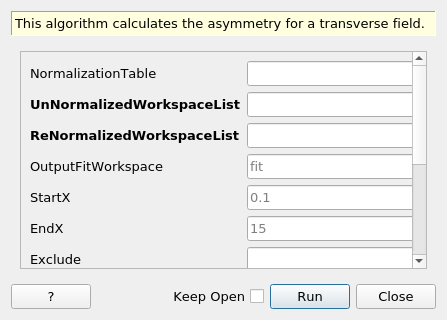\(\renewcommand\AA{\unicode{x212B}}\)
CalculateMuonAsymmetry v1¶

CalculateMuonAsymmetry dialog.¶
Summary¶
This algorithm calculates the asymmetry for a transverse field.
See Also¶
Fit, ConvertFitFunctionForMuonTFAsymmetry, EstimateMuonAsymmetryFromCounts
Properties¶
Name |
Direction |
Type |
Default |
Description |
|---|---|---|---|---|
NormalizationTable |
Input |
Name of the table containing the normalizations for the asymmetries. |
||
UnNormalizedWorkspaceList |
Input |
str list |
Mandatory |
An ordered list of workspaces (to get the initial values for the normalizations). |
ReNormalizedWorkspaceList |
Input |
str list |
Mandatory |
An ordered list of workspaces (to get the initial values for the normalizations). |
OutputFitWorkspace |
Input |
string |
fit |
The name of the output fit workspace. |
StartX |
Input |
number |
0.1 |
The lower limit for calculating the asymmetry (an X value). |
EndX |
Input |
number |
15 |
The upper limit for calculating the asymmetry (an X value). |
Exclude |
Input |
dbl list |
A list of pairs of real numbers, defining the regions to exclude from the fit for all spectra. |
|
InputFunction |
Input |
Function |
Mandatory |
The fitting function to be converted. |
Minimizer |
Input |
string |
Levenberg-MarquardtMD |
Minimizer to use for fitting. Allowed values: [‘BFGS’, ‘Conjugate gradient (Fletcher-Reeves imp.)’, ‘Conjugate gradient (Polak-Ribiere imp.)’, ‘Damped GaussNewton’, ‘FABADA’, ‘Levenberg-Marquardt’, ‘Levenberg-MarquardtMD’, ‘Simplex’, ‘SteepestDescent’, ‘Trust Region’] |
MaxIterations |
Input |
number |
500 |
Stop after this number of iterations if a good fit is not found |
OutputStatus |
Output |
string |
||
ChiSquared |
Output |
number |
||
OutputFunction |
Output |
Function |
The fitting function after fit. |
|
EnableDoublePulse |
Input |
boolean |
False |
Controls whether to perform a double pulse or single pulse fit. |
PulseOffset |
Input |
number |
0 |
The time offset between the two pulses |
FirstPulseWeight |
Input |
number |
0.5 |
Weighting of first pulse (w_1).The second pulse weighting (w_1) is set as w_2 = 1 - w_1. |
Description¶
This algorithm calculates the asymmetry from the first muon spectra in a workspace. in a workspace will be corrected.
The formula for calculating the asymmetry (from counts) is given by:
where \(\tau\) is the muon lifetime (2.1969811e-6 seconds), \(F\) is the number of good frames and \(N_0\) is a fitted normalisation constant. The normalisation is calculated by fitting to the normalised counts which is given by
and the fitting function is given by
and the renormalized data is transformed via the equation:
Usage¶
Example - Calculating Asymmetry: This example is for calculating the Asymmetry for a single data set.
import math
import numpy as np
def makeData(name,norm):
xData=np.linspace(start=0,stop=10,num=200)
yData=np.sin(5.2*xData)
result = (1-yData )*norm
ws= CreateWorkspace(DataX=xData, DataY=result,OutputWorkspace=name)
return ws
#create a normalisation table
tab = CreateEmptyTableWorkspace()
tab.addColumn('double', 'norm')
tab.addColumn('str', 'name')
tab.addColumn('str', 'method')
tab.addRow([11.,"a","Estimate"])
tab.addRow([22.,"b","Estimate"])
ws= makeData("a",2.30)
ws2= makeData("b",1.10)
myFunc='name=GausOsc,$domains=i,Frequency=5.;'
TFFunc = ConvertFitFunctionForMuonTFAsymmetry(InputFunction=myFunc,NormalizationTable=tab,WorkspaceList=["a"],Mode="Construct")
CalculateMuonAsymmetry(NormalizationTable=tab, unNormalizedWorkspaceList=["a"],
ReNormalizedWorkspaceList=["b"], InputFunction= str(TFFunc),
OutputFitWorkspace="fit_result",StartX=0.1,EndX=9.9)
print("Normalization constant for b: {0:.2f}".format(tab.column(0)[1]))
Output:
Normalization constant for b: 2.30
Example - Calculating Asymmetry For multiple data sets: This example is for calculating the Asymmetry for multuiple data sets.
import math
import numpy as np
def makeData(name,norm):
xData=np.linspace(start=0,stop=10,num=200)
yData=np.sin(5.2*xData)
result = (1-yData )*norm
ws= CreateWorkspace(DataX=xData, DataY=result,OutputWorkspace=name)
return ws
#create a normalisation table
tab = CreateEmptyTableWorkspace()
tab.addColumn('double', 'norm')
tab.addColumn('str', 'name')
tab.addColumn('str', 'method')
tab.addRow([11.,"a","Estimate"])
tab.addRow([22.,"b","Estimate"])
tab.addRow([22.,"c","Estimate"])
tab.addRow([22.,"d","Estimate"])
#create original function and workspace
myFunc='name=GausOsc,$domains=i,Frequency=5.;'
myFunc2='name=GausOsc,$domains=i,Frequency=5.;'
multiFunc='composite=MultiDomainFunction,NumDeriv=1;'+myFunc+myFunc2+'ties=(f0.Frequency=f1.Frequency)'
ws= makeData("a",2.30)
ws2= makeData("b",1.10)
ws3= makeData("c",4.1)
ws4= makeData("d",2.0)
TFFunc = ConvertFitFunctionForMuonTFAsymmetry(InputFunction=multiFunc, NormalizationTable=tab,
WorkspaceList=["a","c"], Mode="Construct")
CalculateMuonAsymmetry(NormalizationTable=tab, unNormalizedWorkspaceList=["a","c"],
ReNormalizedWorkspaceList=["b","d"], InputFunction= str(TFFunc),
OutputFitWorkspace="fit_result",StartX=0.1,EndX=9.9)
print("Normalization constant for b: {0:.2f}".format(tab.column(0)[1]))
print("Normalization constant for d: {0:.2f}".format(tab.column(0)[3]))
Output:
Normalization constant for b: 2.30
Normalization constant for d: 4.10
Example - Calculating Asymmetry for double pulse data:
import math
import numpy as np
delta = 0.33
x = np.linspace(0.,15.,100)
x_offset = np.linspace(delta/2, 15. + delta/2, 100)
x_offset_neg = np.linspace(-delta/2, 15. - delta/2, 100)
testFunction = GausOsc(Frequency = 1.5, A=0.22)
y1 = testFunction(x_offset_neg)
y2 = testFunction(x_offset)
N0 = 6.38
y = N0 * (1 + y1/2+y2/2)
y_norm = y1/2+y2/2
unnormalised_workspace = CreateWorkspace(x,y)
ws_to_normalise = CreateWorkspace(x,y)
ws_correctly_normalised = CreateWorkspace(x,y_norm)
AddSampleLog(Workspace='ws_to_normalise', LogName="analysis_asymmetry_norm", LogText="1")
innerFunction = FunctionFactory.createInitialized('name=GausOsc,A=0.20,Sigma=0.2,Frequency=1.0,Phi=0')
tf_function = ConvertFitFunctionForMuonTFAsymmetry(InputFunction=innerFunction, WorkspaceList=['ws_to_normalise'])
CalculateMuonAsymmetry(MaxIterations=100, EnableDoublePulse=True, PulseOffset=delta, UnNormalizedWorkspaceList='unnormalised_workspace', ReNormalizedWorkspaceList='ws_to_normalise',
OutputFitWorkspace='DoublePulseFit', StartX=0, InputFunction=str(tf_function), Minimizer='Levenberg-Marquardt')
double_parameter_workspace = AnalysisDataService.retrieve('DoublePulseFit_Parameters')
values_column = double_parameter_workspace.column(1)
print("Normalization constant is: {0:.2f}".format(values_column[0]))
Output:
Normalization constant is: 6.38
Categories: AlgorithmIndex | Muon
Source¶
C++ header: CalculateMuonAsymmetry.h
C++ source: CalculateMuonAsymmetry.cpp
